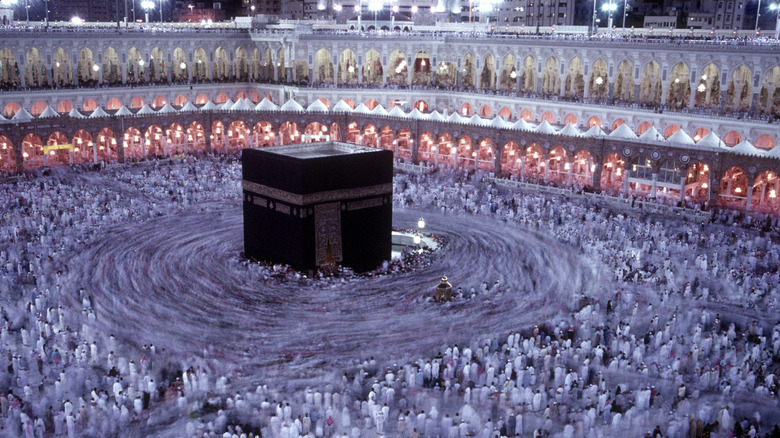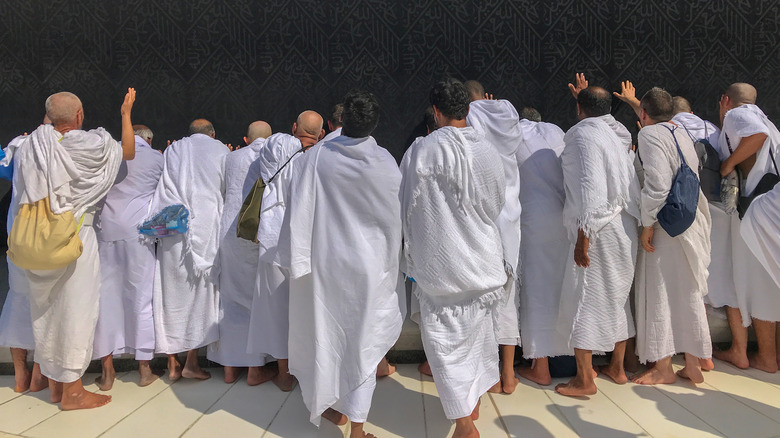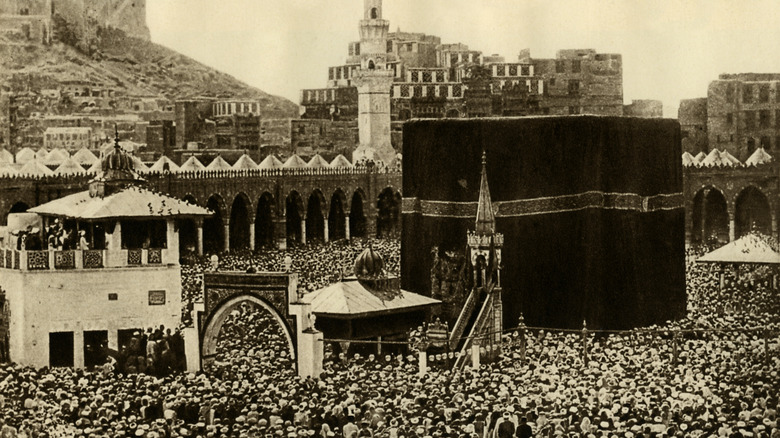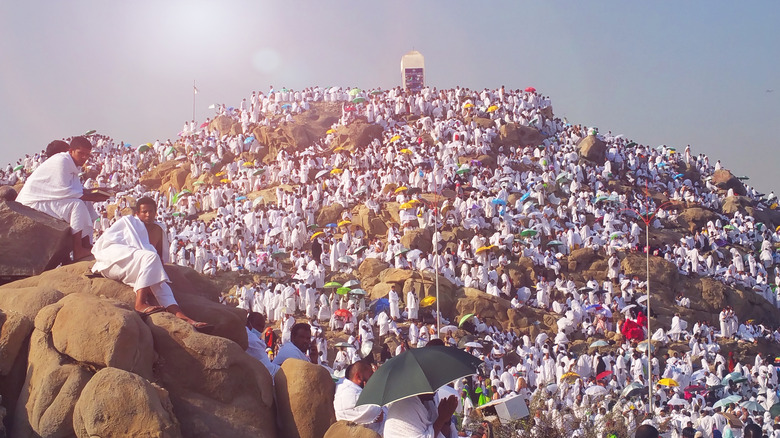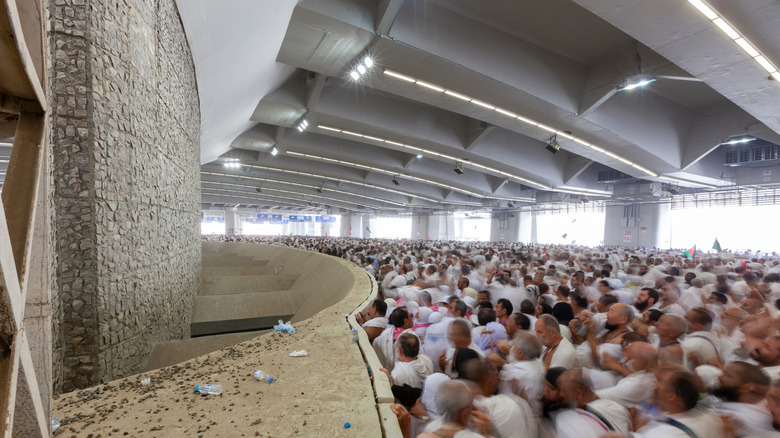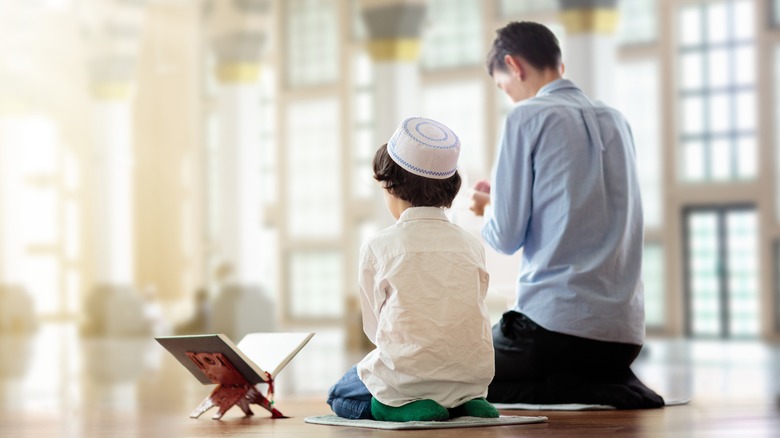What Traditionally Happens To Muslims After Performing The Hajj?
What does it mean to follow the Islamic religion? There are many ways to answer that question, but one of the best is to point to the five pillars of Islam — the central tenets Muslims must follow. The pillars are: faith, prayer, fasting, alms, and pilgrimage — or hajj (via The Met). Hajj is extremely important to Muslims around the world, and while many non-Muslims have seen iconic photos of pilgrims swirling around the Kaaba, most people do not know what the pilgrimage entails nor do they understand the symbolism behind it.
As with the four other pillars of Islam, Hajj traditions stem from the life of the Prophet Muhammad himself, as well as from the story of Abraham. Muhammad was a merchant living in Mecca (modern Saudi Arabia) in the early 7th century, but he was forced to leave his city after he began preaching his new religion. As tensions rose in pagan Mecca, Muhammad embarked on his famous flight (hegira) to nearby Medina to escape persecution and potential death.
Fortunately, some years later, after a great deal of war and strife, Muhammad was able to return, uniting a large part of the Arab world along the way (via History). Today, Muslims copy Muhammad's so-called "farewell pilgrimage," his last trip to Mecca in 632, which took place shortly before his death. Pilgrims imitate Muhammad's actions while in Mecca (via Doha News) — although it should be noted that there is considerable disagreement over how to do Hajj correctly (via Al Jazeera).
Entering a holy state
Muslims who are healthy and able to pay for the trip must make the journey to Mecca at least once in their lifetime. This journey takes place during the last month of the Islamic year across five days (the eighth to the 13th) and is distinct from Umrah — a journey to the holy city that can take place at any time (via Al-Jazeera).
Because there are now approximately 1.8 billion Muslims worldwide (via ADL), Hajj presents some serious logistical problems in the modern age. Today, many Muslims from around the globe have to register for a Hajj visa with the Saudi government before embarking on their journey (via the US Department of State). The crushes caused by large crowds during Hajj caused 717 deaths in 2015. While that number of deaths is a rarity, the sheer number of people on the pilgrimage means that sometimes deaths do occur, according to the BBC.
Still, assuming all goes well, the first step Muslims undergo when they get to Saudi is to enter into a holy state known as ihram. For women, this means donning a headscarf and humble garb, and for men, special white clothing with no stitches is worn (via Doha News). In modern times, Saudi has organized a large changing area at Miqat, the boundary into Mecca, to accommodate pilgrims (via the Saudi Embassy). The state of Ihram includes many prohibitions; participants should not engage in sex, cut their nails, or wear perfume (via Islamic Relief).
Approaching the Kaaba
When travelers arrive in Mecca they approach the Kaaba, which is set in Mecca's grand mosque. This part of the ritual is known called Tawaf. The Kaaba, or the Cube" in Arabic (per Arab News), is a black box dressed in silk and it was a sacred site long before Muhammad was born.
Muhammad reclaimed the site for Islam, claiming it was in fact built by Abraham — the same Abraham venerated by Christians. Having rid the city of pagan idol worship, he thus preserved the holy status of the city of Mecca for future generations (via Arab News).
Travelers circle around the Kaaba in an anti-clockwise direction and (when covid is not an issue according to the BBC) — go up to the famous black stone set into the side of the building, in order to touch and kiss it. Pilgrims perform this procession seven times (via Al Jazeera).
After circling the Kaaba Muslims run between two hills (Safa and Marwa) seven times. According to Muslim tradition, the Kaaba was built to commemorate the creation of the well of Zamzam, found by Abraham's son while wandering the desert. The running between the two hills (the Sa'i), symbolizes the frantic search for water by Abraham's wife (via Islamic Relief).
As the day comes to a close the faithful head to Mina — the world's most spectacular tent city. Today, Saudi provides an incredible 15,000 buses to transport weary travelers to the site (via the Saudi Embassy).
Every Muslim is a brother
Although they may look medieval, the 100,000 tents arranged at Mina today are quite modern — and they come with the luxury of air-conditioning (via Visit Saudi). Time spent at Mina is for prayer and reflection (via Al Jazeera), and it is from here that pilgrims leave to visit Mount Arafat.
Mount Arafat is an impressive site rising dramatically over a vast baking plain, but it is also the site of Muhammad's last Sermon. This Sermon given just before Muhammad's death is a deeply moving message of equality that could have been written yesterday, and that can be appreciated by Muslims and non-Muslims alike.
Muhammad states that: "All mankind is from Adam and Eve, an Arab has no superiority over a non-Arab nor a non-Arab has any superiority over an Arab ..." the passage goes on to say that Black and white people are equals and neither has "superiority" over the other, "except by piety (taqwa) and good action. Learn that every Muslim is a brother to every Muslim and that the Muslims constitute one brotherhood" (via Arab News). At this special place, Muslims perform "the standing," in which they ask for forgiveness from God (via the Saudi Embassy).
Stoning the Devil
After leaving Arafat pilgrims head to rocky Muzdalifah to collect stones. Over the next three days (known as rami), the pilgrims take these stones to a set of enormous stone pillars (the Jamarat), throwing seven pebbles at each (via Islamic Relief). Even those not on Hajj celebrate on this day — Eid al-Adha — a huge festival around the world (via Al Jazeera).
As with the other rituals involved in Hajj, this act goes back to the story of Abraham. The three pillars represent the devil — who according to Muslim tradition tried to tempt Abraham away from sacrificing his son Isaac to God. The angel Gabriel appeared before Abraham and instructed him to throw stones at the devil, to send him away. The stoning Muslims perform is thus a reenactment of this event and a spiritual rejection of Satan himself.
The rituals of Hajj are next brought to a close with the shaving of men's heads (women may also cut their hair if they wish) and the sacrifice of an animal — again imitating Abraham's actions (via the Saudi Embassy). An incredible 600,000 animals or more are slaughtered each year for Hajj, and the meat is given to charity — feeding those who need it most.
Coming home
After one final swirl around the Kaaba (another seven times) Hajj is complete. It is quite common for pilgrims to venture to Medina at this time, as it is also a holy city (via Al Jazeera).
Performing the Hajj is a huge event in a Muslim's life, one that symbolizes brotherhood and spiritual purity (via the Embassy of Saudi). According to Islamic Relief, those unable to go on Hajj are recommended to remember God in other ways at this time, through alms or fasting.
For those who make the pilgrimage though, coming home after Hajj is unsurprisingly a joyous occasion for the pilgrim's family, and may be celebrated in a number of ways. Similar to a baptism in the Christian religion, The Prophet Muhammad is supposed to have declared that those who have taken part in Hajj " ... shall return from it as free from sin as the day on which his mother gave birth to him" (via Learn Religions).
